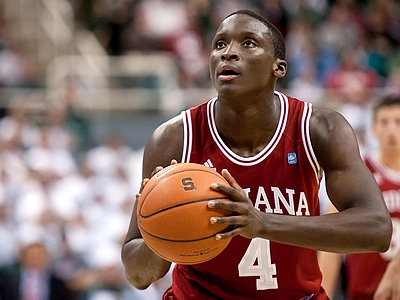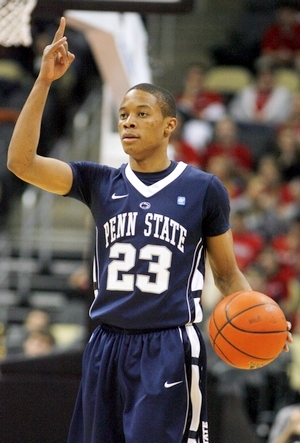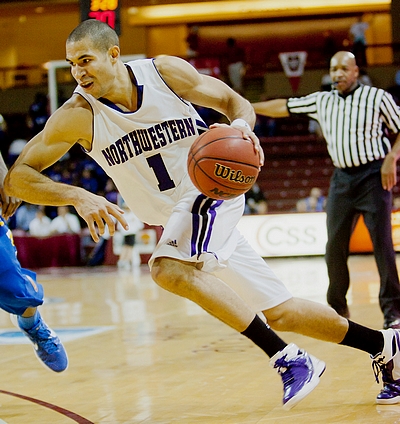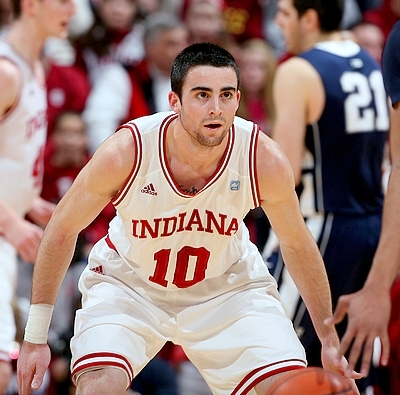Incoming freshmen have been excluded from these previews, as we'd like to wait and see what they have to offer on the NCAA level before we come to any long-term conclusions.
-Top NBA Draft Prospects in the Big Ten, Part One
-(#1) Cody Zeller Video Scouting Report
-Top NBA Draft Prospects in the Big Ten, Part Two
(#2) Trey Burke
(#3) DeShaun Thomas
(#4) Aaron Craft
(#5) Branden Dawson
-Top NBA Draft Prospects in the Big Ten, Part Three (#6-10)
(#6) Trevor Mbakwe
(#7) Adreian Payne
(#8) Brandon Paul
(#9) Keith Appling
(#10) Christian Watford
#11, Victor Oladipo, 6'5, Junior, SG, Indiana

Derek Bodner
With the arrival of Cody Zeller and the turnaround of the Indiana program, Victor Oladipo was in the public's eye far more than he was during his freshman season. Indiana, which had gone a combined 28-66 over the previous 3 seasons, went 27-9 last year, culminating in a competitive Sweet Sixteen loss to eventual tournament champion Kentucky.
During his freshman season Oladipo was a role player who got playing time thanks to his sheer effort, with over 50% of his offense coming from transition, cuts to the basket and offensive rebounds. Those still remain among Oladipo's primary strengths, and where his athleticism and finishing ability allow him to remain productive even as the rest of his game rounds out to form, but they were less prominent as Oladipo tried to expand his role on the offensive end.
Oladipo is beginning to see a larger portion of his offense from isolations and pick and roll sets. Oladipo has excellent tools as a potential slashing wing, with a very good first step, body control, explosion and touch around the hoop. According to Synergy Sports Technology, he shot 60% on field goal attempts around the hoop, which is around the top 25% in terms of efficiency.
Despite his athletic gifts, there are a couple of areas he is currently lacking in that prevent him from being a high volume shot creator. While his ball-handling has improved considerably, it still has a ways to go before he is capable of executing advanced moves and changes of direction with regularity, and he can become turnover prone in traffic. His left hand, in particularly, is still not useful for much more than one or two power dribbles, and his ability to finish with his off hand is still an adventure at times as well.
His jump shot is his other major limiting factor, and probably the biggest hurdle to his finding a spot on an NBA roster at this point. His free throw percentage did improve, from 61.2% on 85 attempts to 75% on 144 attempts, which is a good sign. But he overall shot just 21.1% on jump shots and 17.9% on catch and shoot opportunities according to Synergy Sports Technology, both of which place him among the bottom 10% of collegiate players. The amount that his defender is able to sag off of him limits the angles he has to drive to the basket, and makes it hard to envision him being more than an energy guy at the next level until he shows some more consistency.
Another area of the game that Oladipo is able to provide contribution is on the glass, with his 2.6 offensive rebounds and 7.9 total rebounds per 40 minutes pace adjusted being in the top five among shooting guard prospects in our database. The offensive glass in particular is a way that Oladipo is able to contribute while the rest of his offense is developing, as his toughness, athleticism, and ability to finish around the hoop are rare traits among wing prospects.
Defensively, Oladipo continues to show shut down defensive potential, if only during spurts. He has the physical tools, including length, quickness, and strength to be an incredibly versatile defender, but his fundamentals have not yet caught up to his tools. With a good coach and work ethic, the potential is certainly there as he continues to mature.
With Indiana poised to make another strong NCAA tournament run, Victor Oladipo has a chance to play a large role on a team that will get plenty of exposure, both nationally and in the eyes of NBA scouts. If Oladipo can force defenders to defend him on the perimeter, he has the tools to be a high energy role player in the NBA, and his athleticism and finishing ability could open up doors for an even larger role should he show substantial improvement on his perimeter skills.
#12, Rodney Williams, 6-7, Senior, Small Forward, Minnesota
Having profiled Williams fairly late in the season with a comprehensive scouting report, we've elected to wait and see what type of progress he's made with a fresh perspective in a few months, rather than rehashing many of the same comments made last year based off his 2011-2012 game footage.
#13, Tim Frazier, 6'0.5, Senior, Point Guard, Penn State

Matt Williams
Ranking second in scoring and leading the Big Ten in assists last season, Tim Frazier returns to Penn State to put the finishing touches on a very productive collegiate career. One of the most improved players in the country on paper last season, Frazier took over where Talor Battle left off as the polarizing figure for the 12-20 Nittany Lions as a junior, averaging 18.8 points per-contest, tripling his average from the season before. Likely to place among the most prolific scorers in high-major basketball this season, the rising senior has one last chance to showcase his skills to NBA scouts and carry his team towards the middle of the pack in conference play.
Standing 6'0.5 with a 6'2.5 wingspan, Frazier is a scoring point guard with solid quickness and good speed in the open court. His biggest weakness at the moment is his lack of strength and explosiveness at the rim. His 170-pound frame makes it difficult for him to fight through contact in the lane and he doesn't have the leaping ability to finish over defenders in traffic.
Despite his limitations, Frazier shows the ability to score from all over the court. As both his team's primary scoring threat and ball-handler, the Houston native carries a huge load in Penn State's offense. Every possession it seems he's either running the pick roll, pushing the ball in transition, or creating his own shot one-on-one. Averaging 37.1 minutes per-game, the Nittany Lions go as Frazier goes, his creativity and consistency on a game to game basis play a huge role in their ability to win games.
If there is one thing Frazier shows on a regular basis, it is a degree of creativity and a willingness to accept the challenge associated with lifting his team when his number is called. Playing in one of the best conferences in college basketball, Frazier is the consistent focus of opposing defenses, forcing him to constantly dig into his bag of tricks to keep his team in games. A crafty ball-handler who isn't a blur off the bounce, but who uses changes of speed and direction well on the pick and roll and creates separation with a nice crossover, Frazier is capable of creating his own shot from the perimeter and in the paint when he can find a seem.
Once Frazier has space, he proves to be a capable shooter, albeit not the most efficient one. Like many volume scorers, Frazier's efficiency is limited by the degree of difficulty in the shots he attempts, and his 36.2% shooting on jump shots last year per Synergy Sports Technology seems to belie his fluid release and shooting mechanics.
Unlike Talor Battle, who carried a similar load for PSU a few seasons ago, Frazier is not a prolific three-point shooter, attempting only 2.7 per-game last year. Most of Frazier's shots come from the midrange, where he shows deft touch on his floater and is able to make some circus shots, but tends to struggle when defense collapse around him. Shooting just 46.2% when getting all the way to the rim last season, Frazier compensated to some degree by averaging 6.3 free throw attempts per-game.
As a passer, Frazier averaged 7.1 assists per-40 minute pace adjusted, but does not consistently show dynamic playmaking ability in the lane or when driving and dishing or on the pick and roll. He does, however, do a very good job identifying reading the defense, seeing the open man, and delivering the ball in transition, when defenders cheat to his side of the floor early in an isolation, and when help side defenders arrive late to meet his initial move to the rim. Many of Frazier's mistakes come when he stares down a player in the post or is surrounded by defenders in the paint.
Defensively, Frazier is quick and active, but struggles at times against more physical guards who can match his speed. Showing solid lateral quickness denying dribble penetration, Frazier is not the type of waterbug-type, full-court defender that many of the players his size who have played in the NBA recently have been. He's at his best defensively when offensive players show any amount on indecisiveness in the lane, showing good timing reaching for the ball en route to 2.4 steals per-game.
Tim Frazier has his share of weaknesses as a NBA prospect, but unlike some players in his mold that have come before him, he shows the ability to run an offense, even if his shot selection and shooting volume don't always align with that. A perfect candidate to showcase how he can run a team surrounded by other senior prospects at the Portsmouth Invitational Tournament, battle tested players like Frazier are always in high demand in the European game should the NBA not coming calling his name immediately. If he can show improved efficiency on the offensive end this season, be a more disruptive defender on the ball, shore up his perimeter stroke, and show that he can run a team and score as a roleplayer he'll earn himself plenty of looks come draft season.
#14, Drew Crawford, 6-5, Senior, Shooting Guard, Northwestern

Jonathan Givony
A double-digit scorer and a heavy contributor from day one at Northwestern, it wasn't until his Drew Crawford's junior year this past season that he truly developed into an All-Big Ten caliber player. With leading scorer John Shurna now off to the pro ranks, Crawford looks poised to become his team's go-to guy as a senior. He will try to emerge from relative obscurity on the national level and solidify himself as a legit NBA prospect at the same time.
Crawford has solid physical tools for a college shooting guard, standing around 6-5, with a strong frame, and good, but not great athleticism. He's a relatively fluid and mobile guard who is capable of playing above the rim, but does not appear to possess top-tier explosiveness or an overwhelmingly quick first step.
Playing in the slow, methodical, Princeton-style Northwestern offense, Crawford scored with impressive efficiency last season, converting 52% of his 2-point attempts and 41% of his 3s, while posting a positive assist to turnover ratio. He doesn't get to the free throw line at a great rate, but also rarely commits turnovers, coughing the ball up on just 12% of his possessions last year.
A very intelligent player who takes what the defense gives him, Crawford can do a little bit of everything offensively. He's first and foremost a very reliable shooter with his feet set, capable of coming off screens, and showing excellent shot-selection, one of the big reasons he is so efficient offensively.
While not overwhelmingly quick or explosive, Crawford can make plays inside the arc thanks to his high skill-level and excellent basketball IQ. Showing good timing attacking unbalanced opposing defenses, he can dribble and finish with either hand, and does a good job of anticipating teammates getting open and finding them for easy baskets. With his strong frame, he can also go into the post a bit and score with his back to the basket, which is an added bonus.
Not possessing a terribly fluid or quick release, Crawford still has work to do on his in-between game, as he isn't quite as effective with his pull-up jumper as he is with his feet set. NBA teams might have some question marks about his ability to create his own shot at the pro level, as he already has some difficulties getting by some of the better wing defenders he encounters at times in the Big Ten, which could become even more pronounced in the NBA.
Defensively, Crawford isn't the easiest prospect to evaluate, as his team plays almost exclusively in a zone defense that wasn't particularly effective last season, ranking dead last in the Big Ten. He seems to put a solid effort in, but has some trouble at times staying in front of quicker opposing wing players, appearing to lack a degree of lateral quickness. Seeing most of his minutes at small forward, he's forced to switch onto big men posting up at times in his team's matchup zone concept, something that he can't really do that very effectively at his size.
Nevertheless, Crawford is smart, strong and competitive, so there is plenty of hope that he can become at least a solid contributor on this end of the floor in time.
Going into his senior year, NBA teams will want to see whether Crawford can maintain the same degree of efficiency offensively in a much bigger role now that the keys to the team have been handed to him. If he can continue to shoot the ball well and show improvement as a creator and defender, he'll surely earn plenty of looks playing in the highly competitive Big Ten.
#15, Will Sheehey, 6-6, Small Forward, Junior, Indiana

Joe Treutlein
Will Sheehey has steadily improved his game in his two years at Indiana, establishing himself as a reliable and important role player for the Hoosiers last season. Heading into his junior season, however, Sheehey will have his work cut out for him to take his game to the next level, as Indiana returns all of its top five scorers from last year in addition to a trio of top-100 recruits stepping foot on campus.
Standing 6-6 with a solidly built frame and average length, Sheehey is a good but not great athlete, showing nice explosive ability in open space or when he builds a head of steam, but just showing adequate quickness and speed in more closely contested situations. Sheehey's intangible profile is more clearly positive, as he's an efficient offensive player who brings a good feel for the game and a very high motor to the table, playing with high effort and focus on both ends of the floor.
On the offensive end, Sheehey spends most of his time working as a high-energy, off-the-ball role player, specializing primarily on cuts to the basket and straight-line drives. He does a good job elevating and finishing with power when he finds himself with an open route to the rim, though also shows solid touch when having to finish with finesse.
In addition to his slashing game, Sheehey brings a decent jump shot to the table, shooting a respectable 38.3% from three-point range on the season, albeit on a paltry 1.5 attempts per game. His mechanics are solid and he shows no issues with his range, but taking his spot shooting game to the next level by hitting a higher clip of his shots will likely be critical to his long-term potential given his overall profile.
Sheehey's shot creation skills are not a major selling point for him, as he doesn't consistently show the ball-handling, speed with the ball, or change of direction abilities to be a major isolation threat. He does have a solid array of jab-steps and up-fakes, which he uses to create separation for one or two-dribble pull-ups and straight-line drives, but is mostly just a situational threat here.
On the defensive end, Sheehey has excellent fundamentals, instincts, and focus, consistently playing up on his opponent both on and off the ball and doing a very good job staying in front of his man and contesting shots in isolation. His lateral quickness appears to be just average, but his instincts and effort compensate for that at this level, though it may become more of a concern projecting forward. Sheehey's average physical tools become more apparent defending pick-and-rolls and coming around screens, where he often doesn't have the quickness to keep up.
Looking forward, Sheehey has carved out a solid niche for himself as a role-playing wing at the college level, playing a key role for the Hoosiers throughout his sophomore season, but likely will need to make strides in a few areas of his game to find himself a similar role at the next level. Taking his spot-up three-point shooting to the next level is the most obvious thing he can do to improve his stock, but further improving his ball-handling, shot creation abilities, and defense certainly wouldn't hurt either.
After struggling with injuries at points last season, it's possible that we didn't get to see the best that Sheehey has to offer, as he suggested with a very strong showing at the competitive adidas Nations pickup games this summer. This season will teach us a lot more about his ability to solidify himself on the NBA radar screen, but he'll likely need to find a way to expand his role this year in spite of few minutes for the taking to have a fighting chance.



































Comments